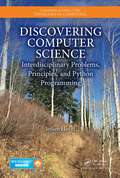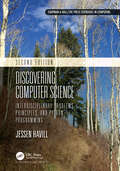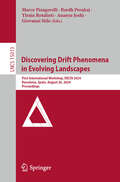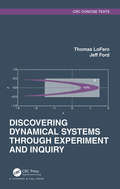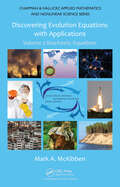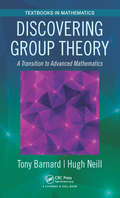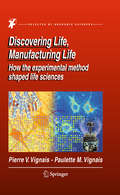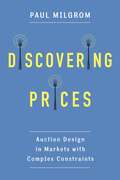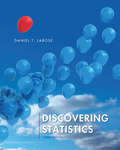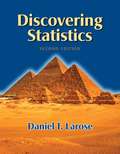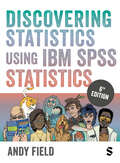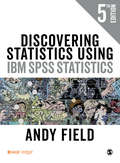- Table View
- List View
Discovering Advanced Algebra: An Investigative Approach (Second Edition)
by Jerald Murdock Ellen Kamischke Eric KamischkeYour journey through Discovering Advanced Algebra will be a meaningful and rewarding experience.
Discovering Algebra: An Investigative Approach
by Jerald Murdock Ellen Kamischke Eric KamischkeNIMAC-sourced textbook
Discovering Algebra: An Investigative Approach (2nd edition)
by Jerald Murdock Ellen Kamischke Eric KamischkeA procedure that you do over and over, each time building on the previous stage, is recursive. You'll see recursion used in many different ways throughout this book. In this lesson you'll draw fractal design using a recursive procedure. After you draw the design, you'll work with fractions to examine its parts.
Discovering Algebra: An Investigative Approach, Lecciones condensadas en español Condensed Lessons in Spanish
NIMAC-sourced textbook
Discovering Computer Science: Interdisciplinary Problems, Principles, and Python Programming (Chapman & Hall/CRC Textbooks in Computing #15)
by Jessen HavillDiscovering Computer Science: Interdisciplinary Problems, Principles, and Python Programming introduces computational problem solving as a vehicle of discovery in a wide variety of disciplines. <P><P>With a principles-oriented introduction to computational thinking, the text provides a broader and deeper introduction to computer science than typical introductory programming books.Organized around interdisciplinary problem domains, rather than programming language features, each chapter guides students through increasingly sophisticated algorithmic and programming techniques. The author uses a spiral approach to introduce Python language features in increasingly complex contexts as the book progresses.<P><P>The text places programming in the context of fundamental computer science principles, such as abstraction, efficiency, and algorithmic techniques, and offers overviews of fundamental topics that are traditionally put off until later courses. <P><P>The book includes thirty well-developed independent projects that encourage students to explore questions across disciplinary boundaries. Each is motivated by a problem that students can investigate by developing algorithms and implementing them as Python programs.The book's accompanying website — http://discoverCS.denison.edu — includes sample code and data files, pointers for further exploration, errata, and links to Python language references. <P><P>Containing over 600 homework exercises and over 300 integrated reflection questions, this textbook is appropriate for a first computer science course for computer science majors, an introductory scientific computing course or, at a slower pace, any introductory computer science course.
Discovering Computer Science: Interdisciplinary Problems, Principles, and Python Programming (Chapman & Hall/CRC Textbooks in Computing #15)
by Jessen Havill"Havill's problem-driven approach introduces algorithmic concepts in context and motivates students with a wide range of interests and backgrounds." -- Janet Davis, Associate Professor and Microsoft Chair of Computer Science, Whitman College "This book looks really great and takes exactly the approach I think should be used for a CS 1 course. I think it really fills a need in the textbook landscape." -- Marie desJardins, Dean of the College of Organizational, Computational, and Information Sciences, Simmons University "Discovering Computer Science is a refreshing departure from introductory programming texts, offering students a much more sincere introduction to the breadth and complexity of this ever-growing field." -- James Deverick, Senior Lecturer, The College of William and Mary "This unique introduction to the science of computing guides students through broad and universal approaches to problem solving in a variety of contexts and their ultimate implementation as computer programs." -- Daniel Kaplan, DeWitt Wallace Professor, Macalester College Discovering Computer Science: Interdisciplinary Problems, Principles, and Python Programming is a problem-oriented introduction to computational problem solving and programming in Python, appropriate for a first course for computer science majors, a more targeted disciplinary computing course or, at a slower pace, any introductory computer science course for a general audience. Realizing that an organization around language features only resonates with a narrow audience, this textbook instead connects programming to students’ prior interests using a range of authentic problems from the natural and social sciences and the digital humanities. The presentation begins with an introduction to the problem-solving process, contextualizing programming as an essential component. Then, as the book progresses, each chapter guides students through solutions to increasingly complex problems, using a spiral approach to introduce Python language features.The text also places programming in the context of fundamental computer science principles, such as abstraction, efficiency, testing, and algorithmic techniques, offering glimpses of topics that are traditionally put off until later courses.This book contains 30 well-developed independent projects that encourage students to explore questions across disciplinary boundaries, over 750 homework exercises, and 300 integrated reflection questions engage students in problem solving and active reading. The accompanying website — https://www.discoveringcs.net — includes more advanced content, solutions to selected exercises, sample code and data files, and pointers for further exploration.
Discovering Drift Phenomena in Evolving Landscapes: First International Workshop, DELTA 2024, Barcelona, Spain, August 26, 2024, Proceedings (Lecture Notes in Computer Science #15013)
by Giovanni Stilo Marco Piangerelli Bardh Prenkaj Ylenia Rotalinti Ananya JoshiThis book constitutes the post-conference proceedings of the First International Workshop on Discovering Drift Phenomena in Evolving Landscapes, DELTA 2024, held in Barcelona, Spain, on August 26, 2024. The 9 full papers presented together with 1 short paper were carefully reviewed and selected from 17 submissions. The papers are grouped into three topical sections, namely: adaptive and robust learning in dynamic environments; challenges and solutions in drift detection and anomaly explanation; and innovative approaches to concept drift detection and landscape shifts.
Discovering Dynamical Systems Through Experiment and Inquiry (Textbooks in Mathematics)
by Jeff Ford Thomas LoFaroDiscovering Dynamical Systems Through Experiment and Inquiry differs from most texts on dynamical systems by blending the use of computer simulations with inquiry-based learning (IBL). IBL is an excellent tool to move students from merely remembering the material to deeper understanding and analysis. This method relies on asking students questions first, rather than presenting the material in a lecture. Another unique feature of this book is the use of computer simulations. Students can discover examples and counterexamples through manipulations built into the software. These tools have long been used in the study of dynamical systems to visualize chaotic behavior. We refer to this unique approach to teaching mathematics as ECAP—Explore, Conjecture, Apply, and Prove. ECAP was developed to mimic the actual practice of mathematics in an effort to provide students with a more holistic mathematical experience. In general, each section begins with exercises guiding students through explorations of the featured concept and concludes with exercises that help the students formally prove the results. While symbolic dynamics is a standard topic in an undergraduate dynamics text, we have tried to emphasize it in a way that is more detailed and inclusive than is typically the case. Finally, we have chosen to include multiple sections on important ideas from analysis and topology independent from their application to dynamics.
Discovering Evolution Equations with Applications: Volume 1-Deterministic Equations (Chapman & Hall/CRC Applied Mathematics & Nonlinear Science)
by Mark McKibbenDiscovering Evolution Equations with Applications: Volume 1-Deterministic Equations provides an engaging, accessible account of core theoretical results of evolution equations in a way that gradually builds intuition and culminates in exploring active research. It gives nonspecialists, even those with minimal prior exposure to analysis, the foundat
Discovering Evolution Equations with Applications: Volume 2-Stochastic Equations (Chapman & Hall/CRC Applied Mathematics & Nonlinear Science)
by Mark McKibbenMost existing books on evolution equations tend either to cover a particular class of equations in too much depth for beginners or focus on a very specific research direction. Thus, the field can be daunting for newcomers to the field who need access to preliminary material and behind-the-scenes detail. Taking an applications-oriented, conversation
Discovering Geometry
by Michael SerraThis text brings the subject to life with investigations, constructions, activities, and projects.
Discovering Geometry An Investigative Approach 4th Edition
by Michael Serra Andres Marti Juan Alvarez Andy Levine Claudia Newell Bill Pasini William Rieser Sue Todd Rose ZgodzinskiNIMAC-sourced textbook
Discovering Geometry: An Inductive Approach (2nd edition)
by Michael SerraThis user-friendly book is designed in such a way that the student learn by doing and both the student and the teacher can have fun with geometry.
Discovering Geometry: An Investigative Approach 4th Edition
by Michael SerraThis book introduces students to reasoning strategies that help them explain their discoveries in Geometry and enable them to justify their conjectures through proof.
Discovering Group Theory: A Transition to Advanced Mathematics (Textbooks in Mathematics)
by Hugh Neill Tony BarnardDiscovering Group Theory: A Transition to Advanced Mathematics presents the usual material that is found in a first course on groups and then does a bit more. The book is intended for students who find the kind of reasoning in abstract mathematics courses unfamiliar and need extra support in this transition to advanced mathematics. The book gives a number of examples of groups and subgroups, including permutation groups, dihedral groups, and groups of integer residue classes. The book goes on to study cosets and finishes with the first isomorphism theorem. Very little is assumed as background knowledge on the part of the reader. Some facility in algebraic manipulation is required, and a working knowledge of some of the properties of integers, such as knowing how to factorize integers into prime factors. The book aims to help students with the transition from concrete to abstract mathematical thinking.
Discovering Life, Manufacturing Life
by Paulette M. Vignais Pierre V. VignaisThis book tells the story of how thinkers, over time, have dared to explore using experimental devices and how the experimental method established itself and took a predominant role in the life sciences. While life sciences continue to advance and knowledge becomes more widespread and accessible, philosophers now focus on problems of ethics particularly with respect to the reproductive functions that contemporary biology is able to manipulate and modify. Looking at the stunning progress made by scientific thought over the last five centuries we might ask ourselves what were the triggering factors that lead to the experimental method. How did this logical and objective approach to the exploration of various enigmas in nature arise and spread at a particular moment in time in the western world? Was there an influence from the social, religious or political context? Was the energy of a few individuals sufficient to initiate such a revolution? The authors of this book take us on journey of the mind, from the ancient roots of scientific rationality to today's irresistible trend in genetic manipulation, particularly focused on human beings. Inevitably this will lead the reader to view the way in which science is done today under a new light. A fascinating discussion, based on concrete examples and experiments, provides food for thought, not only with respect to the experimental method itself, but also regarding the organization of science as it exists today and how it is perceived.
Discovering Prices: Auction Design in Markets with Complex Constraints (Kenneth J. Arrow Lecture Series)
by Paul MilgromTraditional economic theory studies idealized markets in which prices alone can guide efficient allocation, with no need for central organization. Such models build from Adam Smith’s famous concept of an invisible hand, which guides markets and renders regulation or interference largely unnecessary. Yet for many markets, prices alone are not enough to guide feasible and efficient outcomes, and regulation alone is not enough, either. Consider air traffic control at major airports. While prices could encourage airlines to take off and land at less congested times, prices alone do just part of the job; an air traffic control system is still indispensable to avoid disastrous consequences. With just an air traffic controller, however, limited resources can be wasted or poorly used. What’s needed in this and many other real-world cases is an auction system that can effectively reveal prices while still maintaining enough direct control to ensure that complex constraints are satisfied.In Discovering Prices, Paul Milgrom—the world’s most frequently cited academic expert on auction design—describes how auctions can be used to discover prices and guide efficient resource allocations, even when resources are diverse, constraints are critical, and market-clearing prices may not even exist. Economists have long understood that externalities and market power both necessitate market organization. In this book, Milgrom introduces complex constraints as another reason for market design. Both lively and technical, Milgrom roots his new theories in real-world examples (including the ambitious U.S. incentive auction of radio frequencies, whose design he led) and provides economists with crucial new tools for dealing with the world’s growing complex resource-allocation problems.
Discovering Statistics
by Daniel T. LaroseDan Larose's Discovering Statistics is the ideal text for instructors who want to teach the basics of statistical computation as well as how to interpret and apply the results of those computations. Using real data, contemporary examples, step-by-step solutions, extensive pedagogy, and support for common statistical software options, the text familiarizes students with essential computational skills, while helping them build the conceptual understanding needed to interpret and explain their findings. As a result, Discovering Statistics helps students develop a solid and lasting "statistical sense" that will prove valuable throughout their academic and professional careers.
Discovering Statistics (2nd Edition)
by Daniel T. LaroseDiscovering Statistics is intended for an algebra-based, undergraduate, one- or two-semester course in general introductory statistics for non-majors. It will prepare you to work with data in fields such as psychology, business, nursing, education, and liberal arts, to name a few.
Discovering Statistics (2nd Edition)
by James S. Hawkes William H. MarshThe text includes many new real-world problems, very colorful graphics, interesting sidebars, additional topics, and a new chapter on Statistical Process Control.
Discovering Statistics Using IBM SPSS Statistics
by Andy FieldWith its unique combination of humour and step-by-step instruction, this award-winning book is the statistics lifesaver for everyone. From initial theory through to regression, factor analysis and multilevel modelling, Andy Field animates statistics and SPSS software with his famously bizarre examples and activities. Features: • Flexible coverage to support students across disciplines and degree programmes • Can support classroom or lab learning and assessment • Analysis of real data with opportunities to practice statistical skills • Highlights common misconceptions and errors • A revamped online resource that uses video, case studies, datasets, testbanks and more to help students negotiate project work, master data management techniques, and apply key writing and employability skills • Covers the range of versions of IBM SPSS Statistics©. All the online resources above (video, case studies, datasets, testbanks) can be easily integrated into your institution′s virtual learning environment or learning management system. This allows you to customize and curate content for use in module preparation, delivery and assessment.
Discovering Statistics Using IBM SPSS Statistics
by Andy FieldWith its unique combination of humour and step-by-step instruction, this award-winning book is the statistics lifesaver for everyone. From initial theory through to regression, factor analysis and multilevel modelling, Andy Field animates statistics and SPSS software with his famously bizarre examples and activities. Features: • Flexible coverage to support students across disciplines and degree programmes • Can support classroom or lab learning and assessment • Analysis of real data with opportunities to practice statistical skills • Highlights common misconceptions and errors • A revamped online resource that uses video, case studies, datasets, testbanks and more to help students negotiate project work, master data management techniques, and apply key writing and employability skills • Covers the range of versions of IBM SPSS Statistics©. All the online resources above (video, case studies, datasets, testbanks) can be easily integrated into your institution′s virtual learning environment or learning management system. This allows you to customize and curate content for use in module preparation, delivery and assessment.
Discovering Statistics Using IBM SPSS Statistics
by Professor Andy FieldWith an exciting new look, new characters to meet, and its unique combination of humour and step-by-step instruction, this award-winning book is the statistics lifesaver for everyone. From initial theory through to regression, factor analysis and multilevel modelling, Andy Field animates statistics and SPSS software with his famously bizarre examples and activities. What’s brand new: A radical new design with original illustrations and even more colour A maths diagnostic tool to help students establish what areas they need to revise and improve on. A revamped digital resource that uses video, case studies, datasets and more to help students negotiate project work, master data management techniques, and apply key writing and employability skills New sections on replication, open science and Bayesian thinking Now fully up to date with latest versions of IBM SPSS Statistics©. Please note that ISBN: 9781526445780 comprises the paperback edition of the Fifth Edition and the student version of IBM SPSS Statistics. More information on this version of the software's features can be found here.


